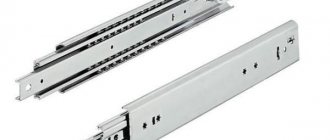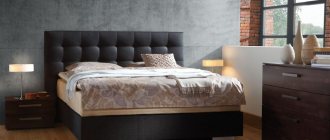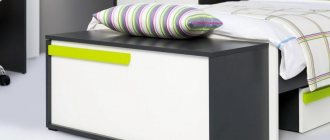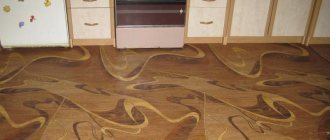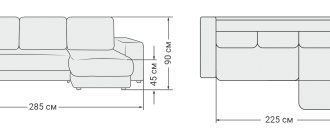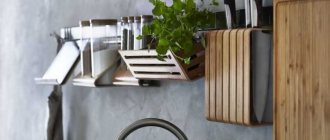A piece of furniture created for a person to sit and rest, without a backrest, can rightfully be called the prototype of a chair. This is a compact, convenient item that can be found in almost any kitchen, bar, or country house. Over time, any furniture wears out, becomes unusable and the question arises about the need to replace it. Many solve the problem radically and head to the store. At the point of sale, they are often faced with the fact that the finished product does not meet the requirements, both from an aesthetic point of view and from a practical one. In this case, you shouldn’t be upset, because you can make a stool with your own hands at home without any problems. It has a fairly simple design, and its manufacture does not take much time.
Simple round stool
To make an original wooden stool with a round lid you need:
- Before you make a simple stool from wood with your own hands using a hacksaw and a set of chisels, you will need to mark the bars.
- Cut out blanks for legs and connecting jumpers, on which it is necessary to provide protrusions.
- Connect the frame elements using the technology used when assembling a square stool with your own hands from wood.
- Mark with a compass a circle corresponding to the diameter of the lid on a sheet of thick plywood, a monolithic board or a package assembled from several plates.
- Cut the workpiece with a hacksaw or jigsaw, and then process the edges with an abrasive tool.
- Place the cover on the base and finish the surfaces.
A simple round stool is a very comfortable piece of furniture.
For country houses, they use the technology of manufacturing round stools of a simplified design. Instead of separate legs, use 2 sheets of plywood or chipboard with connecting grooves. The supports are joined at right angles, and then a round lid is attached on top using wooden pins and adhesive. To increase rigidity, screws and metal corners are installed.
Decoration methods
Ordinary wooden and plywood stools look boring and faceless. The original design is suitable only for a summer house, balcony, or outdoor gatherings. The simplest methods of decoration are plain painting, painting, varnishing. You can create a stylish interior object using the decoupage technique. The method cannot be called simple, but the result will be worth it. Stools can also be decorated with textured wallpaper to match the color of the room’s surfaces or sewn or knitted into soft textile covers.
You can turn a simple stool into an exclusive piece of furniture by decorating its seat with concrete. Such options will look great in a modern, loft, or high-tech kitchen. You can work with a lid of any shape. Pour the solution into a plastic bucket, a suitable container, place the stool with the seat down, distribute the concrete evenly. To prevent the mixture from sticking to the bottom and side walls, they must first be lubricated with oil or soap solution.
Manufacturing procedure
Is it difficult and how to make a stool with your own hands? First you need to decide on the drawing and choose the optimal design. The next stage is preparing the material for manufacturing. Wood, chipboard or plywood must be dried and checked for defects
Then the workplace is set up, special attention is paid to lighting
As an example, we can consider how to make a stool from chipboard.
Production stages:
Sheet marking. This is necessary for the formation of blanks. Beginners are recommended to make patterns from paper or thick cardboard. This way you can avoid sizing errors.
It is important to consider the kerf width tolerances. Formation of blanks. The optimal tool is an electric jigsaw
The edges need to be sanded with sandpaper or a sanding machine. Fastening components. Depending on the design, you can use the slotting method, joining with furniture corners or using wooden tenons. If the structure is made of wood with your own hands, you can use confirmations. This screw fastener secures various components well and improves stability. Painting and varnishing. The finishing surface can be matte or glossy. If it is important to preserve the original texture, use translucent or transparent varnishes. Acrylic compounds are most often used. Additions. Often special shock absorbers are installed on the legs. They minimize the appearance of scratches on the floor and reduce noise when moving furniture.
Decoration
If we talk about decorating stools, there are a lot of ideas that will allow you to turn them into something unique and interesting. Ideas for decorating such products can be divided into 3 large categories:
- woodworking;
- use of various types of pillows;
- the use of various types of capes.
If we talk about the first category, then a very popular type of decoration is the creation of antique stools. For this purpose, there is a special coating for wood, as well as its special processing. Carved models of this type, which are made by professionals, have a fairly high price. But it is not always possible to make such a stool yourself.
But the use of various kinds of pillows is one of the most commonly used methods of decorating such furniture. In addition to the fact that various original pillows make the stool truly unique and interesting, it is also soft and comfortable. After all, often the problem with any stool is that you can’t sit on it for a long time due to the hard surface. And so this problem is solved, and you can enjoy sitting on such a beautiful chair. Another decoration option is the use of various capes. Well, here everything is limited only by the imagination of the owner of such furniture and his financial capabilities. As you can see, today there are many options for decorating wooden stools made with your own hands.
History of the stool
It is impossible to say exactly when man first invented the stool. Many assume that the predecessor of the product was an ordinary log, which was used by primitive people and subsequently modernized it into an object familiar to everyone. If we rely on archeology, then of the samples found, the oldest ones date back to approximately the 4th millennium BC. One of the most famous finds is a folding stool found in Ancient Egypt. It dates back to the times of the Middle Kingdom. This seating structure is kept in the Metropolitan Museum of Art in New York, USA.
On the paintings and reliefs found on the walls of tombs and temples in the same Ancient Egypt, which date back to the 5th millennium BC, there are images of products exactly similar to modern ones, but they are more squat. From the painting on ceramics belonging to the Mesopotamian civilization, the first stools appeared in the region of 3100-2370 BC. However, according to historians, such household items were available only to the nobility; ordinary citizens were deprived of such privileges.
Later, these things migrated to Ancient Greece, where the first examples found in images and bas-reliefs date back to the Aegean period. Ancient Rome then adopted most of the Greek traditions and inventions. After its fall, the item did not sink into oblivion; it was used both in the Middle Ages and in the era of enlightenment. This useful thing is still used today in everyday life, in the kitchen, outdoors, in cafeterias, in medical and public institutions.
Tools and materials
So, in order to make a wooden chair yourself, you need to prepare a number of tools and materials. If we talk about tools, we should name:
- plane;
- Circular Saw;
- drill;
- screwdriver;
- wood hacksaw;
- milling cutter;
- roulette;
- pencil;
- clamps.
If we talk about materials, then you will need to have on hand:
- screws;
- furniture glue;
- sandpaper;
- stain or drying oil;
- masking tape;
- cardboard for stencil;
- dowel or lumber.
Here it should be understood that the choice of wood and the final processing technique will determine the ability of the chair to cope with the effects of natural factors, its stability, reliability and ability to withstand physical stress. For some reason, many people choose chipboard to create a chair, although this material is completely unsuitable for chairs. And especially for garden-type models. The reason is simple - extremely low resistance to moisture. And the strength of chipboard models will be lower than that of solid wood or timber models.
But natural wood, although not the most affordable material, is environmentally friendly and completely harmless. It will be the best solution if you want to make homemade chairs with your own hands. Before starting work, you should inspect the boards and bars for defects - cracks and knots. After this, the material is polished, protective materials are applied to it, and assembly is performed. If we talk about wood, then it would be best to take alder, ash, birch, and oak for such purposes.
There are two reasons here. The first is the presence of an unusual fiber pattern. The second is the high wear resistance of a product made from these materials. And the durability of such products will be high. The only drawback will be deformation under the influence of moisture and low resistance to fire. And one more important point that should also be prepared is drawings and diagrams. This issue should be decided when it is already known what material the furniture will be made from. There are several options to solve this problem:
- make a drawing with your own hand, which will indicate the dimensions and features of this chair;
- do it on a computer;
- download the finished version on one of the specialized sites.
Which option is better to choose will depend on your drawing and computer skills.
Stools on a metal frame - features and advantages
The design of the stool has remained virtually unchanged since its inception. It consists of support and seat components. The latter can be soft (which is much more convenient) or hard. Most models are equipped with a special device that makes it possible to adjust the height and perform rotation around its axis. Folding products are in particular demand. With their help, it is possible to properly organize space in a cramped room.
A special feature of models with a metal frame is the ability to hold a load of up to 150 kg without deformation.
Their main advantages make up an impressive list.
- Ordinary care.
- Beautiful shapes.
- Durability.
- Reasonable price.
- Thanks to the protective coating, they are highly resistant to moisture.
- Versatility.
- The use of removable covers will allow you to frequently make changes to the design.
- The weight in most cases is less than that of products made from solid wood.
It is correct to remember the disadvantages.
A stool on a metal frame does not look very good in the usual design, and also in such directions as eco and Provence style. For these interior solutions, forged structures are better suited.
Metal legs can damage the floor covering, so they must be equipped with rubber or plastic caps.
Sometimes when contacting iron parts, a sitting person may feel discomfort. This is especially true when it is cool outside. An original fabric cover will help correct the situation.
Tips for safe use
When using any lifting mechanisms, it is important to remember several rules:
- Before installing the structure, make sure it is suitable. Inspect for damage, loose fasteners and damaged rubber parts and supports.
- Place the product on a flat surface.
- If you are working on the site, check that there are no holes or stones under the legs.
- Follow the manufacturer's installation recommendations. Extension ladders, for example, need to be installed at an angle of about 75 degrees.
In the assembled product, check all fasteners, clamps and adjusters
It is necessary that everything is tightly latched and closed. Please pay attention to the maximum permissible weight for the product. If there are no rubberized pads on the steps, try to work in non-slip shoes. Store the stepladder according to the manufacturer's recommendations.
To learn how to make a ladder chair with your own hands, watch this video.
Other decor ideas
If there is a tapestry on the cover with an image in its middle, you can place a floral pattern with flowers. Due to the fact that the combinations of shades look dim, this option will not be pretentious, but stylish.
The seats can be decorated with embroidery on the cover. A large flower made using the satin stitch technique will look nice like a tapestry. An interesting option is an ornament along the perimeter or an abstract type of picture. They use strong, non-fading threads that will not wear out due to frequent washing.
Knowing how to make a wooden stool with your own hands, you can create beautiful furniture and save money.
Scope of use
Due to their reliability, stools with a metal frame are used in various fields.
- At home, such products are appropriate in the kitchen, dining room, hallway, etc.
- Bar models can often be found in restaurants and cafes.
- Industrial premises are often equipped with such seating items.
- Beautiful and wear-resistant products are ideal for offices, train stations, shopping centers, airports and other public places.
- Fans of outdoor activities will be happy to take with them a folding version of a metal stool.
- You can also equip a cozy corner in the garden or open veranda, but it is worth considering that not all models are designed for the street.
What do you need for work?
Regardless of the type of structure being manufactured, work must always begin with a drawing of the future project. It is advisable to consider several options so that you have something to compare with and ultimately choose one. The preparatory stage does not end here. You also need to take care of the tools.
Woodworking tools
So, to make a stool you need to prepare the following:
- softwood boards;
- furniture stapler;
- set of self-tapping screws;
- seat upholstery material;
- PVA glue for working with wood;
- sandpaper with different grain sizes;
- hand saw or jigsaw;
- plane;
- screwdriver and electric drill;
- safety glasses and work gloves.
Hand wooden plane
Be sure to prepare paint and varnish materials and decorative finishing products. It is also necessary to purchase various stencils, rollers and brushes for painting the finished product. Once everything you need is at hand, you can get to work.
Manufacturing
As mentioned above, there is nothing particularly difficult about making your own inexpensive but attractive chipboard stool. The main thing is to first draw up detailed drawings and indicate on them all the dimensions of the future structure. Having such an “action plan” in hand will make your work much easier and more convenient, because at any moment you will be able to check whether you are doing everything correctly.
Preparation and cutting of material
The first stage of making a stool from chipboard yourself will be preparing and sawing the specified material that imitates wood. Different craftsmen use different tools for this, but an electric jigsaw is considered more convenient and practical - it’s easier to work with. It is advisable to use a tool with short teeth. The jigsaw should work at the highest speed - this is the only way all the cuts will be clean and even.
Having at hand a template (a detailed drawing with all the details) of the future stool, you can proceed to its creation. The paper or cardboard blank must be attached to the wood boards and outlined with a pencil. This way, it will be easier for you to cut out all the parts efficiently and accurately. All small irregularities remaining after cutting should be removed using sandpaper or sandpaper.
The cut bars must be carefully polished and tried on each other. Sanding is especially important if small households will use homemade furniture in the future. Having prepared all the necessary parts for the future structure, you can move on to the final stage before assembly - drilling all the necessary holes. Make sure that they are all at the same level.
Assembly
When all the parts are cut and prepared, you can begin to directly assemble the stool. Before you start assembling the furniture structure, you need to treat all cut edges with a special ribbon. It should be selected in accordance with the color of the material itself. Ribbons of contrasting colors are also appropriate.
The tape should be applied to the edges of the legs and seats, and then glued using a hot iron. The latter should be applied quickly, making short movements. The heated tape must be pressed down with a clean rag. The glue located on the back side of the applied coating sets almost immediately - it will not heat up or cool down for a long time.
All parts of the stool must be assembled using screws and confirmations. Some craftsmen first glue all the parts and then fasten them with self-tapping screws - it’s easier that way. The seat of the resulting stool can be made soft by installing foam rubber and upholstery.
Decoration
The stool will look more attractive if you equip it with padding and upholstery. The upholstery of such furniture can be oilcloth, woven or leatherette. Each master chooses the best option himself. Foam rubber is often used as filling.
Step-by-step master classes on making a stool
Anyone can easily make a stool with their own hands. Students make the simplest furniture during labor lessons. Simple designs are primitive, consisting of a seat and legs. If you have the right drawing and minimal carpentry skills, making a standard item will not take much time. The preparation of wood materials can be carried out directly in the apartment or on the balcony. You can make your first stool at home using one of the following master classes.
Classic stool
This chair has the simplest design. You can make a classic stool from leftover chipboard, plywood, and boards. You only need a few parts, correctly sized and securely fastened. We begin work by manufacturing the following elements:
- Lid. The shape and size can be any. You can make an elongated seat in the form of a bench, round, or classic square. Before drawing up a drawing, you need to take into account the dimensions of family members and the quality of lumber. The optimal dimensions taken as a basis are 40x40 cm. We take a board 20 cm wide and saw off two pieces of 40 cm in length. We clean the edges and ends with sandpaper.
- Tsargi. We saw off a piece of 28 cm from the prepared board, divide it in length into 4 parts of 5 cm each, remove burrs, and clean all surfaces.
- Leggings. In the same way as the drawers, we make 4 blanks from a piece of 28 cm board, each 3-4 cm wide. To prevent the formation of gaps between the pedestal and the leg, we sand all surfaces well.
- Legs. We make it from a 3x3 cm block. We saw off 4 pieces of 42 cm in length, clean all surfaces. The area that will be located under the stool cover requires special attention.
Material of manufacture
You can make a classic stool from any wood waste. One narrow board or a sheet of plywood will be enough. The tree must be dry, without knots, wormholes, or splits. The optimal thickness is 25 mm. For the legs, a cranial square beam is used. If desired, you can make it round.
Chipboard sheets and 20 mm plywood do not require special preparation for assembly; they are easier to work with. You can separate it with a regular jigsaw. The pattern for preparing parts will be identical to the version made from boards. Any material for a stool should be easy to process, drill, and withstand the weight of an adult.
Assembling the stool
We start assembling from the legs. We place 2 blanks on the table, processed end up. We place a drawer frame flush between them. At the bottom, 10 cm from the end, we install a prong. We fasten all the parts with self-tapping screws on both sides.
We perform the same manipulations with the remaining pairs of products. We connect the structures, add intermediate drawers and footrests. We turn the future stool onto its legs, distribute the blanks for the lid in the upper part, and fasten them with self-tapping screws.
Stool with folding mechanism
An important attribute that increases comfort in any situation, it will especially appeal to fishermen, summer residents and simply lovers of picnics in nature. Thanks to a well-thought-out mechanism, the chair folds comfortably and takes up little space in your hands or in the trunk of your car. It is very easy to make such a stool yourself.
First you need to decide on the model and design of the wooden assistant. It can be a simple stool, a large chair with a backrest, or a simple fisherman's design with a fabric seat.
Beginner carpenters should start by making simple sliding furniture. Projects of ordinary folding stools with a minimum number of parts are suitable. Each person selects the size and height of the product individually.
Material of manufacture
You can make a stool with a folding mechanism from both new and previously used wood materials, provided that they have not lost their strength and decorative characteristics. Parts of broken furniture left over from repairs are suitable. The complete list will depend on the model and size of the folding stool. New consumables can be purchased at any hardware store. To work you will need:
- Pine beam 4x2 cm - 1 piece;
- Board 4x1 cm – 1 piece;
- Sandpaper;
- Screws, nuts, bolts;
- A piece of reinforcement, a metal tube.
Procurement of parts and assembly of the product
Work on the preparation and assembly of parts cannot begin without a drawing. You can use an existing sketch or create your own according to the selected dimensions and design. The simplest and most understandable design is for a folding stool with a square lid made of slats or flat boards. Step-by-step instructions and recommendations will help you quickly assemble a product with a folding mechanism:
- Using a jigsaw, we cut the timber into pieces corresponding to the dimensions of legs 48x4x2 - 4 pcs., crossbars 23x4x2 - 2 pcs., large spacers 32x4x2 - 1 pc., small spacers 27.5x4x2 - 1 pc.
- We round and grind all the ends of the parts.
- We cut one side of the legs at an angle of 45 °C.
- We tighten the crossbars and legs with a clamp and make holes.
- We make 6 pieces of board, measuring 39x4x4 cm.
- We fix the crossbars with a temporary spacer with a clamp.
- We lay the boards on the top surface with a slight indentation and fix them with screws.
- We cut a piece of 30 cm from the reinforcement and cut the threads from both ends with a die.
- We pass a pin through the hole in one of the legs, put a metal tube on it and direct it to the lower part of the opposite similar product.
- We thread the ends of the studs through washers, groovers, and secure with nuts.
- Insert bolts into the remaining holes of the folding stool and close with nuts.
Do not tighten the bolts too much, otherwise the stool will have to be transformed with force, which increases the likelihood of various breakdowns. All structural elements must move freely relative to each other.
Wicker stool seat
An original stool with a wicker seat is suitable not only for a summer house, terrace or balcony. It will fit perfectly into modern interiors. You can use any material for decoration. Beautiful patterns made from hemp rope will look good in a Scandinavian, eco-style. Geometric abstractions, checkerboard weaving made of bright synthetic cords are suitable for rooms in the style of fusion, boho, kitsch, avant-garde, eclecticism.
To create a wicker stool, you can use any unimaginable idea. Furniture can be made suitable for sitting, in the form of a table or footrest. It will be convenient in any case. An option suitable for all parameters will be obtained if you choose the right material, take into account its rigidity and adjust the tension well.
Necessary materials
The frame for all types of such stools is assembled according to a standard design. If such a chair will be used by an adult, in the process of preparing the parts it is necessary to provide several strength enhancers. These can be drawers or footrests.
Wicker instead of the top cover of the stool reduces the stability of the product, so it is necessary to use any opportunities to strengthen the structure. You should also take into account that the larger the seat size, the less stable the wicker chair will be. For manufacturing you will need the following materials:
- Wooden blocks for legs 50x50 mm of any convenient height;
- Boards for reinforcing elements (tsars, legs) 50x25 mm;
- Wooden, metal corners;
- Self-tapping screws;
- Materials for weaving the seat (rope, wires, synthetic, leather belts).
Manufacturing technique
After preparation, cutting out the materials for the frame, they are thoroughly cleaned. Only the most even parts can be stable. A jig is used to make holes at a certain angle. Assembling the stool begins with the legs and footstools. All elements are twisted according to the drawing. For reliability, additional metal corners are installed in the area where the upper part of the legs is connected to the drawers. The frame is ready, you can move on to decorating the seat. You can do this in several ways:
- Using a household rope of two colors. We decide on the direction of weaving and nail one end of the rope to the frame with a furniture nail. We wind with tension on opposite parts of the wooden support. You can use a stapler or glue as additional fastening. We take a rope of a different color and weave it perpendicular to the previous rows, alternating the position. We fix both ropes under the frame.
- Using a thick hiking rope. The weaving method is similar to the previous version, but we will use only one rope. We fasten one end to the frame with nails, and throw the rope over the frame with a gradual shift. Having reached the opposite side, we thread the rope through two of the same ones, forming a diagonal weave.
- Made from leather belts. On the inside of the stool, on one of the drawers, we nail a row of straps and bend them around the entire frame, also fixing it. It is better to take wallpaper nails or self-tapping screws with a press washer. The wider the leather products, the greater the gap between them, the minimum distance is 5 mm. We perform the same procedure with the transverse belts, pulling them alternately through the original tapes.
Plywood sheet stool
Durable combined plywood is suitable for making a stool. There are many design options, differing in composition, design, and number of layers. A traditional stool can have any seat shape. It can be a low simple product, a bar stool, or stylish complex designs.
The most important indicator when choosing a material for a stool is mechanical strength. The plywood sheet must also be elastic and moisture resistant. When purchasing raw materials, be sure to pay attention to the quality labeling. The optimal thickness is 10-18 mm. With proper cutting, one sheet of standard sizes is enough for two beautiful stools.
Drawing and cutting of parts
Having visually divided the sheet of plywood into two parts, you can begin to apply markings. Many furniture manufacturers use the following dimensions: height - 45 cm, seat - 30x30 cm. To ensure maximum comfort, generally accepted figures can be reduced or increased. Markings on the sheet begin with the most complex elements - the legs, according to the following principle:
- We draw a rectangle strictly according to the dimensions of the future product;
- We measure the middle of the long sides and draw a line;
- We retreat 20 cm from the center of each product in different directions and mark the segment;
- We draw lines from these points upward and determine the vertices of the rectangle;
- We lean any round object of suitable size against the lines and draw an arc;
- We round all the lines using an arched product (plate, lid).
Now you can start cutting and collecting parts. We will work with a jigsaw. In order not to leave torn edges and waste time on additional finishing, cutting should be done from the front side of the sheet, only with a new sharp blade. You can also prevent deformation of the plywood by first walking along the contour of the diagram on both sides with a shoemaker’s knife. In the same way we make slits on the legs.
The main, most labor-intensive part of the work is done, let's start assembling the stool. We connect the legs in the center of the crossbar through the groove. We place the seat on the table with the wrong side up, attach the legs, align it in the center, and trace the outline with a pencil. We make shallow holes according to the size of the upper part of the parts, fill them with glue and connect all the elements.
Round cardboard stool
You can make a durable, functional stool from simple cardboard. To work, you will need several large boxes of household appliances and food. The larger the base, the more parts you can place on it.
We begin to create an original stool by preparing the parts. We transfer the drawing to cardboard and cut out the blanks. In each part we make shallow cuts according to the pattern for high-quality joining. Apply PVA glue to all joints and assemble the chair. A few days after drying, the joints must be re-treated with glue. This will add strength to the stool and securely fix all the elements. Painting and varnishing will help make a new piece of furniture waterproof.
Drawing of a wooden stool
As usual, at the very beginning we need to draw our future stool on a piece of paper, with all sizes and shapes. Since we will be making the product according to our sample, its drawing will look like this.
We purchase dry timber Let's immediately make a reservation about the timber and slats, you need to buy them in the store, already processed and definitely from the dryer. You can find out whether the slats are dry or not from the store salesperson; as a rule, you can find them in a hardware store. And one more thing, the length of the slats and the length of the timber in the store will differ from the one we need. Don't worry, you'll just need to calculate according to the dimensions above and then cut them to the size you need.
And one more thing, if you are already planning to make a stool with your own hands, then make a set of 4-5 pieces at once. The only adjustment will be in the amount of material needed for the required number of stools.
Gluing the shields
Let's get started, first we need to glue the shield for our seat. To do this, take 9 slats and place them on a flat surface, width apart from each other, and apply PVA glue to one side of each slats. We tighten them tightly with clamps, as shown in the photo.
Making the legs While the glue dries, let's start making the legs. In principle, we won’t have to do a lot of work at this stage; we need to make a cut on the legs of our stool for beauty. To do this, all the legs need to be trimmed (sawed off) to the net size, namely: 4.5X4.5×45 cm. This will be our net size in length, but not yet in width and thickness, we’ll get to that a little later.
In order to make a beautiful cut, you need to measure 20 cm from the bottom of the leg to the middle and make the cut thickness 1.5 cm, this is done something like this:
And we trim (saw off) along the entire length. That is, it turns out that at the bottom of the leg the size will be 3x3 cm and smoothly towards the middle it will change to its initial size of 4.5x4.5 cm. In the end it will be as shown in the photo.
Manufacturing and assembly of the product frame
To manufacture and assemble the frame, you need to make 8 drawers, otherwise the drawers are called stability diameters, 4 drawers to the top of the frame and 4 to the middle. We take our slats and cut them to length, that is, we need to cut 8 drawers of 21 cm each. Then we take the legs and make through holes in them using a screwdriver and a wood drill, the drill should be 8 mm in diameter. at the same moment we attach the drawer.
It turns out that we have a through hole in the leg, and the drill enters the side by 2-3 cm. The side must be applied first from the top, and then to the middle. Next, we smear the chops with glue and hammer them with a mallet one by one into each leg and drawer, in the end you should get a frame like this. We disassemble the panels and polish the irregularities. Now we disassemble our glued panel and prepare it for the seat. First, we trim the shield to a size of 35x35x2.5 cm. After trimming, we take a manual grinding machine and put an 80 belt on it, sand our shield a little, removing rough irregularities and dried glue, that’s what we’re talking about:
As soon as the rough irregularities are sanded, you need to put on a tape number 120 and sand it clean. If chips or unevenness still remain, then putty and after the putty has dried, sand again, thereby you will get a perfectly smooth and clean seat, something like this. Gluing the seat to the frame Now we will glue our seat to the frame. To do this, take the frame and apply glue to the upper part of the end along the entire length. We measure 5 cm on the seat on all sides and measure it with a pencil and apply it along the marked lines of the seat to the top of the frame. You can also fix it either with clamps, or put something heavy on top. You need to wait 24 hours until it dries completely. Carrying out paint and varnish work Well, now you can move on to varnishing, painting or staining (at your discretion). To do this, first take sandpaper number 180 and manually process the stool with your own hands, remove the remains of dried glue and minor irregularities, and bring the product to perfection! Afterwards, if you are going to varnish, take the varnish and mix thoroughly and, if necessary, add solvent 646.
We apply a thin layer of varnish to the product, we recommend using a quick-drying varnish, otherwise such varnish is called (nitro). We wait 2-3 hours, take sandpaper No. 180 and remove the pile raised after varnishing, this pile looks like this:
But don't get carried away, as you can remove the varnish from the product. Then we open it with varnish a second time, at this stage the pile will not rise significantly, but still go through it a little with sandpaper and remove the rest of the raised pile. And with the third layer we complete the varnishing; at this step there is no need to remove the lint. Final photo Our DIY wooden stool is ready, enjoy it to your health!
Types of structures
Based on the type of construction of stools on a metal frame, there are 2 groups: stationary and folding.
The first type is characterized by high reliability.
If you save every centimeter of space, then you should think about buying folding stools. As if by magic, additional seats will appear at the table. And then they can be hidden again in a closet or pantry. An unpleasant surprise can be a breakdown of the mechanism if the permissible load is exceeded. Typically, folding models are designed to carry less weight than stationary ones.
DIY transformable stepladder chair.
THIS IS FANTASTICALLY USEFUL FURNITURE
Let's consider making your own transformable chair, which is very practical for household use and which, with a slight movement of the hand, folds out into a stepladder, ladder or shelf and back. Below in the gallery are drawings and photos of a master class on making such a chair with your own hands.
This chair, originally designed by Benjamin Franklin, was created for libraries. But later, due to its incredible usefulness, this transformable chair became very popular in ordinary American families. One such thing replaces three, a chair, a shelf and a ladder. Very practical in small apartments or dorm rooms.
Drawings and master class
Preparing for work
Before starting work, you should create a drawing of the stool. When drawing up a sketch of a future structure, you should immediately apply all the necessary parameters.
It is absolutely not necessary to carry out a drawing in strict compliance with all the laws of drawing. It will be enough to draw the diagram by hand. The main thing is that the master himself can understand how and what needs to be done.
You can use the drawing diagrams available on the relevant websites.
For beginners who are getting down to business for the first time, let us explain a few specific terms:
- drawers - wooden scraps that fasten the legs of the structure;
- leg - an element that gives stability to the stool. It is located at the bottom of the legs and holds them together;
- “crackers” - corners made of metal or wood, located in the inner corners of the stool under the seat.
When drawing up sketches, be sure to clearly indicate not only the external dimensions of the stool, but also the parameters of all internal elements.
What metal are they made from?
For the frame of a metal product the following is used:
- cast aluminum;
- anodized aluminum pipe;
- forging parts;
- steel hollow profile of square or round section.
Metal models are not prone to corrosion processes and are light in weight. They are in no way inferior to steel in terms of rigidity and strength. The surface is able to retain its true color and matte finish. In many cases it is polished. It is possible to apply a coating that imitates bronze, silver or gold, as well as any shades of colors. The classic option is allowed - chrome plating.
A steel profile will cost much less. The material is gentle to moisture, due to this there is always a protective layer on it. For example: galvanic coating for bronze, chrome or polymer-based powder paint.
The creative process of a stool begins with cutting pipes in accordance with the dimensions of the structure. All edges undergo detailed processing. To do this, a chamfer is removed from the ends. Using a special device, the workpieces are given the required shape, flattened at the joint, and holes are punched for fastening. The frame can be assembled by welding or using bolts and nuts.
Stools with a forged frame are less common. The process of their manufacture is quite complicated, which is reflected in the final price.

